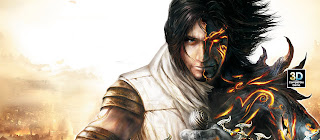The Prince's Tale: A Look at Immersion and Game Storytelling in The Sands of Time Trilogy
The Prince of Persia the Sands of Time trilogy
is not only a view into effective game storytelling and design, but also is a another example of how immersion is
not always reliant on player choice. These games instead show that narrative
can be just as immersive an avenue of game design as that of the open world .
Though what makes these game experiences so unique is not their reliance on
narrative, but instead their ability to tell the story through both game design
and their focus on player immersion through emotional investment in the games
characters.
 Throughout the trilogy the Prince is
referred to as just that, the Prince of Persia, yet this Prince with no past or
name to speak of will emerge as a character who is as emotionally engaging and
interesting as any of his contemporaries. Some though may argue that the Prince's
story is not really his. As with most video game characters the Prince was
given his name in order to allow players to become him, in other words the
Prince and the player are one and the same.
Throughout the trilogy the Prince is
referred to as just that, the Prince of Persia, yet this Prince with no past or
name to speak of will emerge as a character who is as emotionally engaging and
interesting as any of his contemporaries. Some though may argue that the Prince's
story is not really his. As with most video game characters the Prince was
given his name in order to allow players to become him, in other words the
Prince and the player are one and the same.
If this though is the case then the
player's actions are very limited in how they can affect the game's outcome.
The Prince's tale, is the Prince's tale, and nothing the player does will ever
change that. The Prince will always defeat the vizier, will always save
Babylon, and always be infected by the Sands of Time. Therefore, the Prince is
not the player, nor does the developer want them to be, in the sense that the
outcome of the story is dictated by player choice.
It is evident though that the developer wants
the player to affect the story, not
through player choice, but instead through their emotional investment in the
Prince's journey. The Prince is separate from the player with his own experiences,
emotions and faults. This is emphasized by the fact that the game is third person. As a result the player is able
to see how the Prince's world has affected him, and guess as to how his journey
will ultimately end. All of this information is gained through how the player views the character as
a full 3-D model. In a sense the player is given a 360° window into the Prince's
past. they are able to see all of his scars, tattoos and wounds, to get an unparalleled
look into what makes him who he is.
It is then, not the player's choices
that make them the Prince, but instead how relatable the Prince's story is to the
player's own experiences. The player is able to immerse themselves in the
journey of this wayward prince, because of the way the story is told. It is here
that myth comes into play, from the games use of the naïve hero and his unwillingness
to do his duty, to his story of redemption.
The Sands of Time Trilogy is full of mythic ideals and characters that are innately
human in the way they are portrayed
 Therefore, the player can easily
relate to the Prince and his struggles. In a sense the player is the Prince, not
in the literal sense of course, but in the emotional one. They are able to
understand what the Prince is going through, which in a way gives them more opportunities
to affect and be affected by the story. Each player comes to the game with
different experiences, because of this, even though the Prince's story is told in
the same way to every player, they do
not experience it in the same way. The game furthers this idea when the Prince
says "Come and I will tell you a tale like none that you have ever heard."
The Prince therefore may tell the story,
but each player experiences it differently.
Therefore, the player can easily
relate to the Prince and his struggles. In a sense the player is the Prince, not
in the literal sense of course, but in the emotional one. They are able to
understand what the Prince is going through, which in a way gives them more opportunities
to affect and be affected by the story. Each player comes to the game with
different experiences, because of this, even though the Prince's story is told in
the same way to every player, they do
not experience it in the same way. The game furthers this idea when the Prince
says "Come and I will tell you a tale like none that you have ever heard."
The Prince therefore may tell the story,
but each player experiences it differently.


Comments
Post a Comment